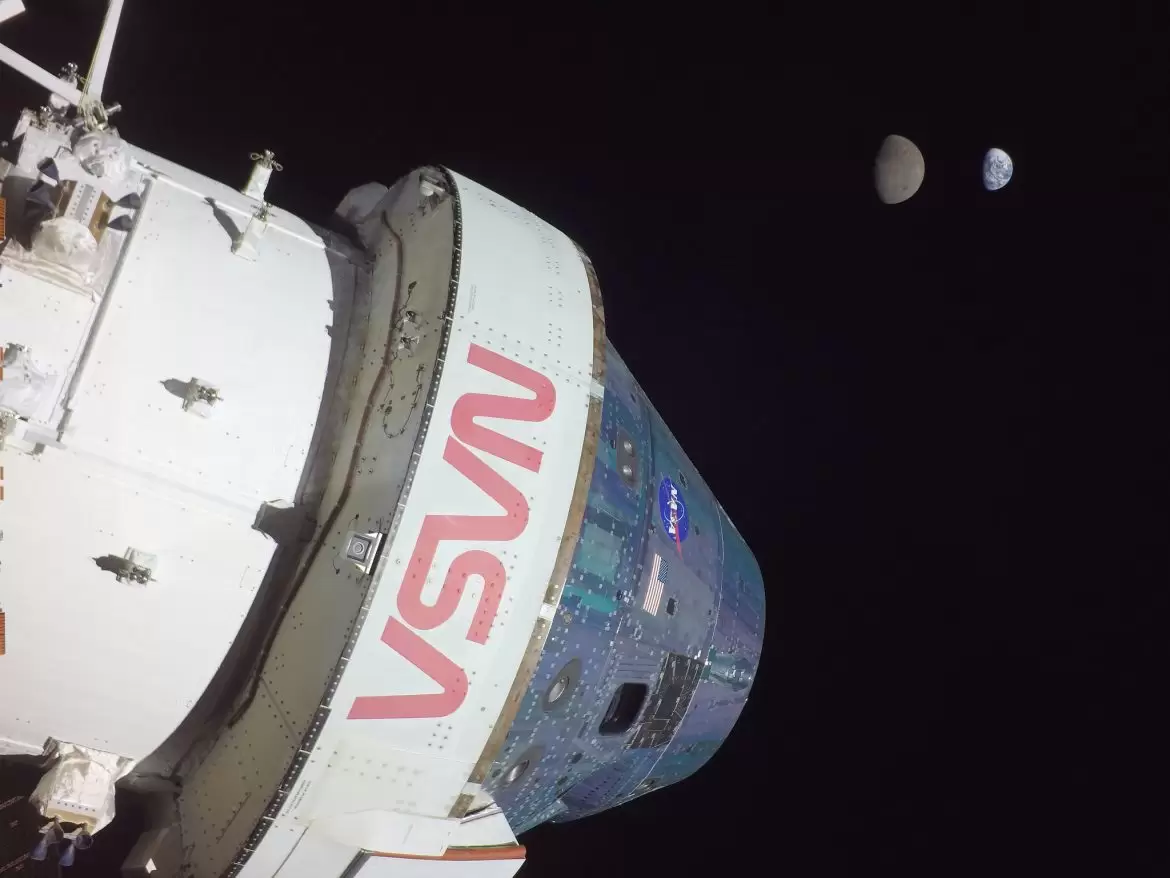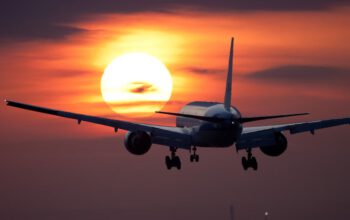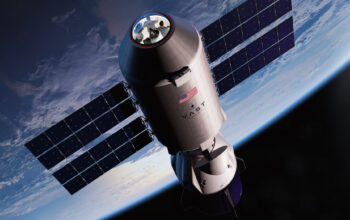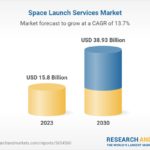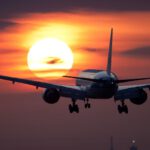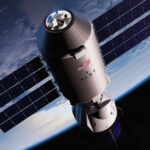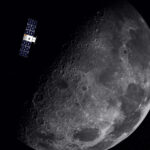NASA launched its mega Moon rocket for the first time, sending its uncrewed Orion spacecraft around the Moon; kicked off a new era in astronomy with the Webb Space Telescope's record-breaking new imagery from the cosmos; moved an asteroid in humanity's first ever planetary defense demonstration; working with its partners, sent astronauts on regular missions to the International Space Station, tested new technologies, including an inflatable heat shield for Mars; continued development of quieter supersonic aircraft, and much more.
Clicking on the “Read Full Article” link below will auto-scroll you to the full post (same page).
Source: NASA
Photo Source: NASA
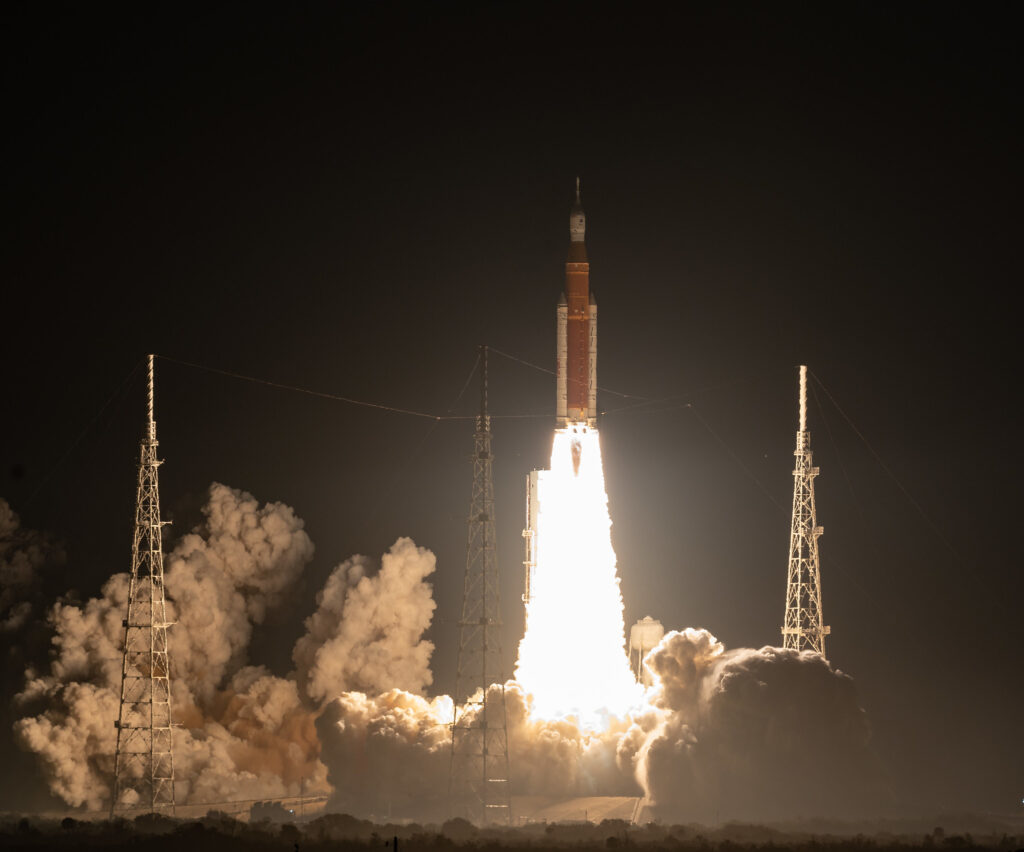
NASA's Big 2022: Historic Moon Mission, Webb Telescope Images, More
“There is no doubt that 2022 was out of this world! From the history-making splashdown of the Artemis I mission, to the groundbreaking images from NASA's James Webb Space Telescope to the innovative LOFTID technology demonstration, the smashing success of the DART mission, incredible progress in our aeronautics programs, and the growth of partnerships with commercial and international partners,
2022 will go down in the history books as one of the most accomplished years across all of NASA's missions,” said NASA Administrator Bill Nelson. “There's so much to look forward to in 2023 too: More stunning discoveries from Webb telescope, climate missions that will tell us more about how our Earth is changing, continued science on the International Space Station, groundbreaking aeronautics developments with the X-59 and X-57 experimental aircraft, the selection of the first astronauts to go to the Moon in more than 50 years, and more. Space is the place and NASA proves humanity's reach is limitless!
In support of the Biden-Harris Administration's priorities, the agency remained a global leader in providing data related to climate change including unveiling a concept for a new Earth Information Center, and published NASA's first Equity Action Plan. Congress also passed, for the first time in five years, a NASA Authorization Act. And in 2022, NASA reached a decade of excellence by being named as the Best Place to Work in the federal government among large agencies by the Partnership for Public Service for an unprecedented 10th consecutive time.
Preparing for human lunar exploration
Among the accomplishments for NASA's human spaceflight programs, the agency successfully launched, for the first time, its Space Launch System (SLS) rocket, which put NASA's Orion spacecraft on a path that traveled farther than any spacecraft built for astronauts has been before. Through Artemis, the agency advanced plans to send the first woman and first of color to the Moon. Leading up to the historic
Nov. 16 launch of Artemis I, as well as a successful Orion splashdown on Dec. 11, NASA completed multiple key milestones for SLS, Orion, and ground systems:
- Worked to assemble the rocket's core stage at the agency's Michoud Assembly Facility in New Orleans and the crew module at Kennedy, selected the vehicle that will transport astronauts to the launch pad, and qualified the final launch abort system engine for the Artemis II mission, the first flight with crew.
- Completed manufacturing the booster segments and delivered the engine section to Kennedy for the Artemis III mission, which will be humanity's first return to the lunar surface in more than 50 years and land the first woman on the Moon.
- Fired a ground-based version of a booster in Promontory, Utah, for future missions, completed the critical design review for the more powerful evolved configuration of the SLS rocket, known as Block 1B, and began moving toward a services contract model for long-term SLS hardware production and operations to reduce costs.
The agency also completed numerous key Artemis milestones that will ensure not only a human return to the lunar surface, but long-term exploration on and around the Moon in preparation for sending the first astronauts to Mars:
- Identified 13 candidate landing regions near the lunar South Pole where the next American astronauts on the Moon could land during Artemis III, selected Axiom Space to provide the moonwalking system, including spacesuits, that astronauts will use during Artemis III, as well as awarded a task order to Collins Aerospace to develop new spacesuits for the International Space Station.
- Awarded a contract modification to SpaceX to further develop its Starship human landing system to meet agency requirements for long-term human exploration of the Moon, including a second crewed landing demonstration mission during Artemis IV, and announced a call to companies to provide proposals for sustainable lunar lander development as the agency works toward a regular cadence of Moon landings beyond Artemis IV.
- Issued a draft request for proposals for Lunar Terrain Vehicle services to solicit companies' feedback and completed desert analog mission with crew in a simulated lunar environment to test pressurized rover operations and moonwalks for future Artemis missions.
- Built on past international partnerships for long-term exploration at the Moon with Japan and South Africa, as well as added new signatories through the Artemis Accords with Bahrain, Colombia, Israel, Nigeria, Romania, Rwanda, and Singapore.
- Released a revised set of Moon to Mars Objectives, forming a blueprint for shaping human exploration throughout the solar system.
- Researchers from the University of Florida grew Arabidopsis thaliana plants in lunar soil gathered during Apollo missions, showing that plants have the potential to grow on the Moon
Maintaining human presence in low-Earth orbit
The NASA Authorization Act passed by Congress extended America's participation in the International Space Station through at least Sept. 30, 2030, enabling the U.S. to continue to reap the benefits for the next decade while the agency works with American industry to develop commercial destinations and markets for a thriving space economy.
This was the 22nd continuous year of human presence aboard the orbiting laboratory. Here are some accomplishments in 2022:
- NASA and SpaceX successfully launched and returned crew members to and from the International Space Station from the agency's Kennedy Space Center in Florida. Regular crew rotation flights to and from station continue to help maximize science in space, including:
- NASA astronauts Kayla Barron, Raja Chari, Tom Marshburn, Kjell Lindgren, Mark Vande Hei, Bob Hines, Jessica Watkins, Frank Rubio, Nicole Mann, and Josh Cassada lived and worked aboard the station.
- This year saw Vande Hei completing the longest single human spaceflight mission by an American with a record-breaking 355 days in space.
- Crew-3 returned to Earth in May with Barron, Chari and Marshburn, as well as ESA (European Space Agency) astronaut Matthias Maurer. During their science expedition aboard the orbiting laboratory, the Crew-3 astronauts conducted experiments, including a study on concrete hardening in microgravity, research on cotton varieties that could help develop drought-resistant plants, and executed a space archaeology study that could provide information that contributes to the design of future space habitats.
- Crew-4 launched in April and returned in October with Hines, Lindgren, and Watkins, as well as ESA astronaut Samantha Cristoforetti after completing 170 days in orbit. Crew-4 continued work on investigations documenting how improvements to the space diet affect immune function and the gut microbiome, determining the effect of fuel temperature on the flammability of a material, exploring possible adverse effects on astronaut hearing from equipment noise and microgravity, and studying whether additives increase or decrease the stability of emulsions.
- Crew-5 arrived at station in October carrying Mann and Cassada, as well as JAXA (Japan Aerospace Exploration Agency) astronaut Koichi Wakata and Roscosmos cosmonaut Anna Kikina. Crew-5 is spending several months aboard the space station conducting new scientific research in areas such as cardiovascular health, bioprinting, and fluid behavior in microgravity to prepare for human exploration beyond low-Earth orbit and to benefit life on Earth.
- NASA and Boeing successfully launched and returned the company's CST-100 Starliner spacecraft from Florida's Cape Canaveral Space Force Station and landed in the desert of the western United States, completing the uncrewed Orbital Flight Test-2 (OFT-2) to the space station to help prove the system is ready to fly astronauts. Starliner and its crew of NASA astronauts Barry Wilmore and Sunita Williams are preparing for the first flight with astronauts in 2023, the final demonstration prior to regular flights to the microgravity complex.
- Crew members welcomed the first NASA-enabled private astronaut mission, Axiom Mission 1, to the orbital complex advancing the agency's goal of commercializing low-Earth orbit.
- Space station crew members are planned to complete 14 spacewalks to upgrade and conduct maintenance at the orbiting laboratory. NASA astronauts continued work to install the International Space Station Rollout Solar Arrays (iROSA), which will increase power generation capability by up to 30% when fully complete, and its partners continued outfitting the Nauka module and new European robotic arm.
- Northrop Grumman's Cygnus spacecraft completed its first limited reboost of the International Space Station – the first mission to feature this enhanced capability as a standard service for NASA.
- The International Space Station performed a critical demonstration focused on in-orbit housekeeping by deploying about 172 pounds of trash from the NanoRacks Bishop Airlock for a safe disposal in Earth's atmosphere.
- Four commercial cargo missions delivered more than 30,000 pounds of science investigations, tools, and critical supplies to the space station, and two returned about 8,900 pounds of investigations and equipment to researchers on Earth.
- Selected seven new additions to the team of flight directors to oversee operations of the space station, commercial crew, and Artemis missions to the Moon.
Advancing our understanding of Earth, climate change
In 2022, NASA continued its commitment to understanding impacts of climate change on planet Earth, maintaining its role as a leader in understanding climate and Earth science. Among the accomplishments in this area, the agency:
- Launched NASA's newest Earth science instrument to the International Space Station — the Earth Surface Mineral Dust Source Investigation, or EMIT, which is providing information about how mineral dust affects the heating and cooling of the planet and which has a capability to detect methane.
- Plans to launch the Surface Water Ocean Topography mission in partnership with the French space agency Centre National d'Études Spatiales, which will provide a global survey of nearly all water on Earth's surface, providing insight into the ocean's role in how climate change unfolds.
- Announced and released the first concept for NASA's Earth Information Center, which will allow people to see how our planet is changing. It will also provide easy-to-use information and resources to support decision makers in developing the tools they need to mitigate, adapt, and respond to climate change.
- Celebrated 50 years of the Landsat program in partnership with the U.S. Geological Survey, continuing to help scientists track both natural and human-caused changes on Earth's land surface.
- Continued field campaigns that provide information about Earth's changing climate, including impacts on the Arctic region, the effects of intense summer thunderstorms, and ocean and atmosphere dynamics and their impacts on Earth's climate
- Along with partners, including the U.S. Department of Agriculture, NASA continued to put Earth science data into the hands of America's farmers to help them increase food security, improve crop resilience, and reduce the volatility of food prices.
- NASA participated in the Commodity Classic conference for the first time, America's largest farmer-led, farmer-focused educational and agricultural experience.
- NASA's Cynthia Rosenzweig received the 2022 World Food Prize from the World Food Prize Foundation for her research to understand the relationship between climate and food systems and forecast how both will change in the future.
- Announced NASA's new domestic agriculture consortium at the University of Maryland, which will lead management of $15 million, supporting efforts to increase and enable sustained uses of Earth observations for the advancement of U.S. agricultural practices.
- Worked with national and international partners to collaborate on a global response to climate change, with actions including participating in the 27th United Nations Climate Change Conference, issuing a comprehensive climate action plan with FEMA, finalizing an agreement with ESA to advance global understanding of Earth science and ensure continuity of Earth observation, and continuing a 60-year successful partnership with the Australian Space Agency to study Earth's changing climate.
- Conducted, or participated in, a series of climate change studies related to rising sea level, global surface temperatures and melting Arctic ice,
- Continued planning for the next generation of Earth-observing satellites designed to propel us forward in understanding our changing planet — NASA's Earth System Observatory.
- Launched two weather satellites for the National Oceanic and Atmospheric Administration, building on a partnership of over 50 years, successfully launching more than 60 satellites to improve weather forecasting, severe storm and hurricane prediction, and climate observations.
Solar system, beyond
While preparing for a robotic return to the lunar surface, NASA advanced its Commercial Lunar Payload Services (CLPS) initiative closer to home. Meanwhile, farther in the solar system, NASA's James Webb Space Telescope deployed and captured new images, Hubble continued to make new discoveries, the agency conducted two Venus flybys, and more:
- NASA's James Webb Space Telescope successfully unfolded into its final configuration in space, including the unprecedented deployment of its tennis court-sized sunshield. In July, NASA and its partners unveiled Webb's first full-color images and spectroscopic data. Since then, Webb has drawn back the curtain on some of the earliest galaxies ever observed; studied the atmospheres of exoplanets in more detail than ever before; and offered new views of planets in our own solar system, capturing the clearest look at Neptune's rings in decades. The U.S. Postal Service celebrated Webb's successes by issuing a new stamp featuring an illustration of the telescope.
- NASA's Double Asteroid Redirection Test (DART) successfully impacted its target asteroid in the world's first-ever test for planetary defense. Since then, the mission's Investigation Team confirmed DART's kinetic impact successfully moved its target asteroid into a new orbit, marking the first-time humanity has ever altered a celestial body's motion in space.
Through CLPS, NASA selected two new science instrument suites – including one that will study the mysterious Gruithuisen Domes for the first time – for priority Artemis science on the Moon through the agency's Payloads and Research Investigations on the Surface of the Moon (PRISM) call for proposals. NASA also awarded Draper a contract to deliver Artemis science investigations to the Moon in 2025. The experiments riding on Draper's SERIES-2 lander are headed to Schrödinger Basin, a large lunar impact crater on the far side of the Moon, close to the lunar South Pole.
- NASA's Hubble Space Telescope spotted the farthest individual star ever seen, whose light took 12.9 billion years to reach Earth – a huge leap further back in time from the previous record holder. For the first time, Hubble also provided direct evidence for a lone black hole drifting through interstellar space by a precise mass measurement of the phantom object.
- In a cosmic milestone, the total number of confirmed exoplanets in NASA's Exoplanet Archive reached 5,000, representing a 30-year journey of discovery led by NASA space telescopes.
- NASA's Imaging X-ray Polarimetry Explorer (IXPE) began its science mission in space. Since then, IXPE has revealed the shape and orientation of matter around black holes, surprised astronomers with unexpected findings on the magnetic field orientations of supernova remnant Cassiopeia A, and helped solve the mystery surrounding a black hole jet.
- Solar Cycle 25 is nearing solar maximum in 2025 and the Sun's activity is already exceeding expectations.
- Smothered in thick clouds, Venus' surface is usually shrouded from sight. But in two flybys of the planet, Parker used its Wide-Field Imager, or WISPR, to capture its first images of Venus in visible light.
- When the Hunga Tonga-Hunga Ha‘apai volcano erupted in January, it sent atmospheric shock waves, sonic booms, and tsunami waves around the world. Scientists analyzed data from NASA's Ionospheric Connection Explorer, or ICON, mission and ESA's Swarm satellites to find that the volcano's effects also reached space.
- As Voyager, NASA's longest-lived mission, logs 45 years in space and studies the very nature of space far beyond the planets, NASA selected Geospace Dynamics Constellation to help improve our understanding of the dynamics of the Sun, the Sun-Earth connection, and the constantly changing space environment. Multi-slit Solar Explorer and HelioSwarm missions to help improve our understanding of the dynamics of the Sun, the Sun-Earth connection, and the constantly changing space environment.
- Researchers continued to pioneer scientific discovery using NASA's Cold Atom Lab, the first quantum physics facility aboard the International Space Station.
- Supporting future Artemis missions and lunar science with Biological Experiment-01. Four investigations aboard Artemis I helped pave the way for future missions to the Moon and beyond.
- Celebrated 25 years of continuous robotic exploration of Mars, with at least one spacecraft operating at all times, either on the surface or in orbit around the planet.
- The Ingenuity Mars Helicopter now is scouting for a possible landing spot for a future Mars Sample Return campaign.
- NASA and ESA entered into a formal agreement on the next step in their campaign to return scientifically selected samples from Mars and are proceeding with the creation of a sample tube depot on the Red Planet.
- After eight successful years of science operations, the Stratospheric Observatory for Infrared Astronomy (SOFIA) completed its final science flight. This now-retired mission leaves behind a legacy of scientific accomplishments and engineering ingenuity.
Developing New Technologies for Benefit of All
NASA advances capabilities for space exploration, tapping entrepreneurs, researchers, and innovators across the country for solutions that will enable missions for decades to come. From launching space missions to demonstrating advanced technologies to supporting the development of early-stage concepts, 2022 highlights include:
- CAPSTONE – short for Cislunar Autonomous Positioning System Technology Operations and Navigation Experiment – launched and entered a unique orbit at the Moon, beginning its mission to test the orbit planned for Artemis' Gateway outpost and demonstrate new technologies.
- LOFTID, or the Low-Earth Orbit Flight Test of an Inflatable Decelerator, successfully demonstrated an inflatable heat shield technology that could be used for human missions to Mars.
- The Laser Communications Relay Demonstration (LCRD) began its in-orbit experiments to test a new way to send data from space.
- Launched Lunar Flashlight to the Moon, where the small satellite will use lasers to hunt for ice in permanently shadowed regions at the Moon's South Pole.
- An instrument on the Perseverance rover, MOXIE – short for the Mars Oxygen In-Situ Resource Utilization Experiment – completed more runs on the Red Planet, producing a total of 140 minutes to date of breathable oxygen from Mars' carbon dioxide rich atmosphere.
- NASA and the Department of Energy announced fission surface power concept awards to three companies.
- Awarded a contract for the development of a next-generation spaceflight computing processor to enable future exploration missions.
- Selected three companies to further advance work on deployable vertical solar array systems that will help power the agency's human and robotic exploration of the Moon under Artemis.
- More than 700 organizations from all 50 U.S. states and 46 countries joined NASA in fostering lunar technology development through the Lunar Surface Innovation Consortium.
- Winners of the inaugural NASA TechLeap Prize – Autonomous Observation Challenge No. 1 tested their technologies on high-altitude balloon flights less than a year after the competition was launched.
- NASA Innovative Advanced Concepts fostered early-stage, futuristic ideas, such as custom, 3D-printed spacesuits, swimming micro-robots to explore ocean worlds, and a new kind of solar sail.
- NASA's Small Business Innovation Research and Small Business Technology Transfer programs supported the investment of approximately $230 million to hundreds of U.S. small businesses to foster technology development supporting the agency's goals.
- NASA transferred technologies and software to industry and entrepreneurs, executing 164 licensing agreements and 4,772 software usage agreements.
- Agency investments in the development of novel roll-out solar arrays (ROSAs) were used to power the DART mission and enable a sufficient future power supply for the International Space Station.
- Early career researchers advanced agency capabilities in areas including nanosensor technologies, dynamic visual displays for spacesuit helmets, and modular, reconfigurable robotic arms for in-space assembly through new and continuing projects under the Early Career Initiative.
- In partnership with multiple agencies, NASA issued a joint solicitation to extend the lifespan of 3D tissue chips

Progressing toward new era of air travel
NASA worked with its partners and the private sector to advance sustainable aviation by developing and testing new green technologies that will revolutionize air transportation. The knowledge and technology generated by the agency will provide regulators and industry with new ways to integrate sustainable solutions. Over the past year, the agency:
- Supported research to reach net-zero carbon emissions by 2050 through its Sustainable Flight National Partnership, including composite material testing under Hi-Rate Composite Aircraft Manufacturing and the development of a smaller engine core through Hybrid Thermally Efficient Core.
- Reached new milestones in its Quesst mission with its centerpiece, the X-59 quiet supersonic demonstrator aircraft, starting with critical ground tests and ending the year with the installation of the aircraft's engine. Other progress included wind tunnel tests at NASA's Glenn Research Center in Cleveland and in Japan.
- Tested the high-voltage systems and batteries for the all-electric X-57 Maxwell aircraft before installing its 400-pound battery packs, paving the way for future ground and flight tests. The project will share its knowledge to advance U.S. development of smaller sustainable all-electric vehicles.
- Issued a call for private sector proposals under its Sustainable Flight Demonstrator project for an aircraft and technologies that can help inform the design of low-emission, single-aisle commercial airliners in the near future. NASA will issue an award in early 2023.
- Completed ground tests with the Boeing ecoDemonstrator program to compare the levels of soot particles in sustainable aviation fuel versus traditional jet fuel burning in a 777-200ER aircraft's engines.
- Formalized an international research agreement and added new partners to its Advanced Air Mobility (AAM) mission. AAM projects explored how to integrate autonomous drones and other future aircraft into emergency response, healthcare, and perimeter surveillance. Research also addressed the noise new aircraft may generate and vertiports they'll need to take off and land.
- Unveiled upgrades to the AAM National Campaign's Mobile Operations Facility, which be used to support AAM flight testing.
- Tested Transonic Truss-Braced Wing aircraft technology designed to burn 8-10% less fuel than traditional winged aircraft.
- Conducted research for the agency and private sector using its Electric Aircraft Testbed including tests of a hybrid electric propulsion system powerful enough for a single-aisle commercial airliner.
- Advanced development of an innovative, solid-state battery pack that would be lighter, safer, and more suited to aviation than today's batteries.
- Used a 3D printing process to develop a new metal alloy, known as GRX-810, that can be used for applications including the insides of aircraft and rocket engines. The alloy can endure temperatures over 2,000 degrees Fahrenheit and survive 2,000 times longer than existing alloys.
- Partnered with Boeing to create shape-shifting devices that can raise or lower an airplane's vortex generators, wing components that cut down on drag a save on fuel consumption.
- Provided researchers from the Scalable Traffic Management for Emergency Response Operations with training from the U.S. Forest Service and the California Department of Forestry and Fire Protection to understand controlled burns and aerial firefighting strategies.
- Broke ground for the Flight Dynamics Research Facility at NASA's Langley Research Center in Hampton, Virginia. This new wind tunnel will have new capabilities and lower maintenance costs.
- Conducted crash tests at Langley of a model of a midsize jet and a full-scale urban air mobility-style passenger vehicle, generating data about the resilience of composite materials and the likelihood of injuries in crashes.
- Selected new participants for the University Leadership Initiative, with students and researchers taking on some of the toughest challenges in aeronautics.
- Launched its newest competition for university students, Runway Functions: Predict Reconfigurations at U.S. Airports.
Prioritizing Diversity, Equity, Inclusion, and Accessibility (DEIA)
This year, NASA developed and launched an agencywide DEIA Strategic Plan to recruit, hire, support, engage, and retain the most talented and promising individuals, from all backgrounds and life experiences, to be part of the NASA family. NASA also:
- Launched its first Equity Action Plan to expand opportunities for traditionally underserved, underrepresented, and untapped communities to work with and learn from NASA.
- Through its Spanish-language outreach, NASA continued to translate many of its products, particularly those related to the agency's science missions. As part of the Equity Action Plan, NASA is committed to growing its Spanish-language communications team and translation capabilities.
- Ensured accessibility of NASA collected Earth science information, by making 54 of the most requested environmental data sets available on the cloud, with full transfer of NASA Earth science data to the cloud by 2025.
- Supported ongoing efforts to advance racial equity and expand research opportunities for historically underserved and underrepresented communities in the federal government through Earth science research grants for Minority Serving Institutions.
- Hosted an Equity Stakeholder Town Hall to openly share ideas on how the agency will continue to support underserved and underrepresented communities, and to gain insights from attendees on how to best implement the next phase of the plan.
- NASA awarded 39 proposals ($6.9 million for up to three years) focused on advancing progress on equity and environmental justice in the U.S. through the application of Earth science, geospatial, and socioeconomic information.
- Developed a 360-degree, interactive Artemis exhibit for nationwide events that includes excerpts from NASA's First Woman graphic novel and underscores the agency's plans to land the first woman and first person of color on the Moon.
- NASA astronaut Nicole Mann was the first Indigenous woman for NASA to go to space as part of Crew-5 mission to the International Space Station, and NASA astronaut Jessica Watkins became the first Black woman to serve a long duration mission aboard the orbiting laboratory.
- Produced and released a documentary, The Color of Space, featuring a conversation between seven current and former Black astronauts, each of whom were selected to become part of NASA's astronaut corps and train for missions to space.
- Collaborated with Google Arts & Culture to showcase the contributions of NASA's LGBTQ+ employees and how their work advances the agency's priorities.
- Launched the SMD Bridge Program to foster collaboration and partnerships between NASA centers and Historically Black Colleges and Universities, Minority-Serving Institutions, Primarily Undergraduate Institutions, and high research universities. The program focuses on paid research and engineering internships, apprenticeships, and research experiences for faculty.
- Hosted a series of dialogues with agency leaders and other subject matter experts during the 51st Congressional Black Caucus Legislative Conference in Washington.
- Hosted a Twitter Spaces with science experts who discussed how space imagery is an experience people can read, touch, and hear via alternative text, rich image descriptions, tactile panels, 3D printed models, tactile plates, and sonifications.
- Connected more than 220 industry stakeholders and businesses with federal procurement experts and other leaders during its first virtual LGBTQ+ Vendor Equity Forum.
Inspiring Artemis Generation through Science, Technology, Education, and Math
Through a variety of STEM outreach activities, NASA sought to inspire a new generation of students and encourage them to become the next scientists, engineers, and astronauts. NASA conducts its STEM work through partnering with key organizations, awarding a variety of grants, and more. STEM highlights in 2022 include:
- NASA Administrator Bill Nelson helped kick-off a new initiative to deliver food and hands-on STEM kits, called Artemis Learning Lunchboxes, this summer. The joint initiative with the Center of Science and Industry (COSI), has since expanded across the country, landing most recently at public school in Washington Dec. 8.
- Collaborated with the Department of Education to enhance the federal Historically Black Colleges and Universities (HBCU) Scholar Recognition Program using NASA entrepreneurial expertise. A NASA pitch competition for students at higher education institutions it became part of the HBCU Scholar Recognition Program, part of the White House Initiative on Advancing Educational Equity, Excellence, and Economic Opportunity. The competition will be a small-scale version of NASA's Minority University Education and Research Program (MUREP) Innovation and Tech Transfer Idea Competition (MITTIC).
- The agency's Minority University Education and Research Program (MUREP) Innovation and Tech Transfer Idea Competition (MITTIC), a Shark Tank-style competition for students at minority-serving institutions, was officially included in the 2022 historically Black colleges and universities (HBCU) Scholar Recognition Program.
- Awarded a total of nearly $600,000 to 10 minority-serving institutions (MSIs) across the U.S. to amplify the voices of diverse innovators and help their ideas find a way into NASA's programs through MUREP and STMD through M-STTR.
- Chose two students as winners of the Lunabotics Junior Contest, a national competition for K-12 students featuring the agency's Artemis missions. Contestants were charged with designing a robot that can dig and move lunar soil, or regolith, from one area of the lunar South Pole to a holding container near a future Artemis Moon base. design.
- Selected 57 winning teams in its inaugural nationwide TechRise Student Challenge, designed to attract, engage, and prepare future science, technology, engineering, and mathematics professionals.
- Produced several educational resources for schools and educators to bring the excitement of NASA's missions to classrooms including Artemis Learning Pathways, Artemis Camp Guide, James Webb Space Telescope Toolkit, and Earth Science Toolkit.
- Vice President Kamala Harris hosted an evening of NASA STEM activities at the Naval Observatory for military families and local students and their families in June, which included a special screening of Disney Pixar's Lightyear.
- NASA and Rice University in Houston hosted multiple events in September to celebrate the 60th anniversary of John F. Kennedy's historic speech at Rice Stadium, rallying the nation to land astronauts on the Moon before the end of the decade and bring the crew safely back to Earth.
- Awarded more than $4 million to institutions across the U.S. to help bring the excitement of authentic NASA experiences to groups of middle and high school students who are traditionally underserved and underrepresented in STEM.
Public engagement
Inspiration remains the foundation of NASA's public engagement programs. While safely returning to regularly conducting in-person activities as well as hosting virtual events and digital communications, NASA provided opportunities to connect people around the world with agency content. Highlights in 2022 included:
- Grew the agency's social media following to 330 million so far in 2022 – up 18 percent from 280 million in 2021.
- Shares on social media posts across the agency reached 8.7 million in 2022, surpassing the pace of 2021 (8.3 million shares), but lower than 2020's record of 12.7 million shares, stimulated by NASA's SpaceX demonstration flight with crew and the Mars Perseverance rover launch.
- Four flagship NASA accounts reached follower milestones this year, passing 65 million (Twitter), 25 million (Facebook) and 85 million (Instagram). NASA's flagship YouTube channel passed 10 million subscribers. The NASA Headquarters photo team surpassed three million followers on Twitter and over 36,000 followers on Flickr.
- On Sept. 26, the audience for our DART mission's intentional crash into target asteroid Dimorphos peaked at one million live viewers; the audience for the liftoff of Artemis I peaked at 960,000 viewers on Nov. 16. Many more viewers watched recordings of agency broadcasts, with the Artemis I launch, our first-ever live launch broadcast in HD, surpassing 10 million YouTube plays. The replay of DART's impact has gotten more than 5.4 million views.
- “The Astronaut's Perspective” was nominated for an Emmy in the Outstanding Science and Technology Documentary category. This video includes beautiful Earth views and reflections from NASA and international partner astronauts.
- NASA hosted 14 Twitter Spaces in 2022, including the agency's first-ever Spaces events in Spanish. Over 465,000 unique listeners joined a live Spaces.
- Returned to hosting in-person NASA Social events in 2022, beginning with NASA's SpaceX Crew-4 launch to the International Space Station. Social media guests also attended NASA Socials for the reveal of the Webb telescope's first images, the DART mission impact, the launch of SpaceX Crew-5, and the Artemis I test flight.
- Won three Webby Awards and five People's Voice Webbys in 2022 and had two additional nominees and four honorees.
- On NASA.gov, the “Where Is Webb” feature tracking the telescope's journey to L2 and deployment had 36 million pageviews in 2022, the fourth-most-visited page on all NASA websites. Six of the top 10 most-viewed agency news releases in 2022 were about the telescope; two of these releases were in Spanish.
- There were almost 4.5 million pageviews of the Send Your Name on Artemis special feature, with nearly 3.4 million members of the public signing up for a boarding pass around the Moon on Artemis I. Web specials highlighting Artemis, the Artemis I test flight, and tracking Artemis I each topped 2 million pageviews.
- During the first half of the Artemis I 25-day flight test, the app for tracking the mission received more than 2.1 million visits.
- NASA launched a virtual educational platform for STEM+Arts Day and a digital launch packet, focused on the agency's Webb telescope.
- The agency incorporated images from the Webb Telescope in its exhibits and media events at the Space Symposium in Colorado Springs, Colorado, and the International Astronautical Congress in Paris.
Among the many collaborations that allowed NASA to educate and inspire new audiences:
- Astronaut Snoopy took a ride around the Moon on Orion as the zero gravity indicator for the Artemis I mission as part of a partnership with Peanuts Worldwide that extends back to the Apollo era.
- LEGO Education held a four-day build event at NASA Kennedy featuring STEM challenges connected to the “Build to Launch” STEM series that LEGO Education created in partnership with NASA. The agency also worked with LEGO to help identify NASA content that fed into several Artemis-inspired LEGO City Moon sets.
- Krispy Kreme released a one-day Artemis doughnut to celebrate Artemis I.
- NASA and Google Arts & Culture partnered to create a digital gallery called, “Our Solar System: A 3D adventure through our cosmic neighborhood with NASA,” which includes more than 60 3D models of planets, Moons and NASA spacecraft. These models, along with a newly released SLS 3D model, are also featured via Google Search results.
- NASA worked with Google on a Webb telescope Doodle celebrating the first images, as well as a DART easter egg where, after the successful DART asteroid redirect, results on Google's search page were skewed when a user searched for DART on Google's home page.
- Multiple screens in Times Square and in Piccadilly Circus featured the Webb First Light Images shortly after their release in July, sharing the excitement these images created with even more people around the world.
- NASA unveiled a new partnership with Crayola Education in 2021 and worked with Crayola and Harper Publishing to help celebrate the 75th anniversary of the iconic children's story, Goodnight Moon.
- NASA worked with Mattel and the ISS National Lab, which sponsored the project, to film NASA astronauts Kayla Baron and Raja Chari on the space station for an episode of a Barbie series, “You Can Be Anything.” The purpose of the free video was to inspire young students to be interested in STEM careers.
NASA maintains high visibility, engaging new audiences in innovative ways, whether it's through partnerships, arts or entertainment projects that reach millions of people. In 2022, NASA collaborated on over 150 documentary projects, 29 notable television programs and 19 feature films which reached audiences globally.
- NASA developed an exhibition of 15 pieces from the agency's art collection at the National Academy of Sciences in Washington, which had not been on display in over a decade. New items included the Kehinde Wiley Moon Person award, on loan from MTV, and Andy Warhol paintings in the collection.
- NASA collaborated with studios on feature films, including Roland Emmerich's Moonfall starring Halle Berry (Lionsgate), Lightyear (Disney), Richard Linklater's Apollo 10/1-2 (Netflix), A Million Miles Away (Amazon: post-production) starring Michael Pena, and Project Artemis (Apple TV: preproduction) produced by Scarlett Johansson. The agency also collaborated on more than a dozen Artemis documentaries with outlets ranging from Smithsonian/Paramount+ to National Geographic/Disney. TV programs of note include Snoopy Season 2 (Apple TV), Top Chef, Jeopardy, and Comedy Central's The Daily Show with Trevor Noah, which included an interview with Webb Space Telescope Program Director Greg Robinson
The agency attracted major talent for various mission related projects and outreach initiatives. These included:
- Video content for Artemis I with Eddie Vedder, Yo-Yo Ma and the Philadelphia Orchestra, Josh Groban and Herbie Hancock, Jack Black, Keke Palmer, Patrick Wilson and Chris Evans.
- Halle Berry conducted an Instagram live with NASA's Johnson Space Center Director Vanessa Wyche and NASA astronaut Victor Glover. She also walked the red carpet for Moonfall with NASA astronaut Jeanette Epps.
- NASA astronaut Tom Marshburn visited the agency's Jet Propulsion Laboratory with Chris Evans for a tour and downlink with the space station. Marshburn also attended the premiere of Buzz Lightyear. A special screening of the film was held at the VP's residence with NASA astronauts, Keke Palmer and Uzo Aduba.
- Coldplay did a special Webb image global release during their concert tour in Berlin.
- Additional talent that visited NASA's Johnson including Carrie Underwood, Taraji P. Henson, Nick Jonas, and Marshawn Lynch. Actor Channing Tatum visited NASA's Kennedy Space Center in Florida.
- Space station downlinks were arranged between astronauts and Eddie Vedder, Jack Black, Richard Linklater and Yo-Yo Ma.
- Special movie screenings aboard the space station included Apollo 10-1/2 and Buzz Lightyear.
- NASA also participated in a National Symphony Orchestra concert at Wolf Trap for Star Wars: The Empire Strikes Back with a special segment on the Webb telescope.


